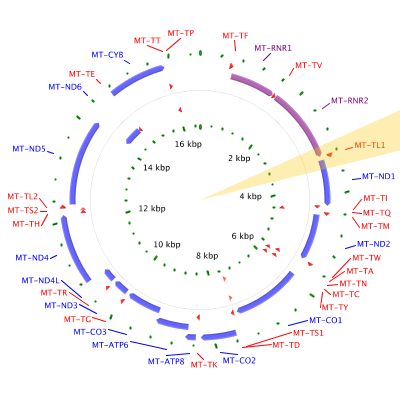 |
About Site Map Contact Us
|
|
| A service of the U.S. National Library of Medicine® | ||
|
MT-TL1
|
MT-TL1On this page:
Reviewed October 2012
What is the official name of the MT-TL1 gene?The official name of this gene is “mitochondrially encoded tRNA leucine 1 (UUA/G).” MT-TL1 is the gene's official symbol. The MT-TL1 gene is also known by other names, listed below. Read more about gene names and symbols on the About page. What is the normal function of the MT-TL1 gene?The MT-TL1 gene provides instructions for making a molecule called a transfer RNA (tRNA), which is a chemical cousin of DNA. Transfer RNAs help assemble protein building blocks (amino acids) into functioning proteins. The MT-TL1 gene provides instructions for making a specific form of tRNA that is designated as tRNALeu(UUR). During protein assembly, this molecule attaches to the amino acid leucine (Leu) and inserts it into the appropriate locations in the growing protein. The tRNALeu(UUR) molecule is present only in cellular structures called mitochondria. These structures convert energy from food into a form that cells can use. Within mitochondria, tRNALeu(UUR) is involved in the assembly of proteins that carry out a series of chemical steps called oxidative phosphorylation. This process uses oxygen, simple sugars, and fatty acids to create adenosine triphosphate (ATP), the cell's main energy source. In certain cells in the pancreas, called beta cells, mitochondria also play a role in controlling the amount of sugar (glucose) in the bloodstream. In response to high glucose levels, mitochondria help trigger the release of a hormone called insulin. Insulin regulates blood sugar levels by controlling how much glucose is passed from the blood into cells to be converted into energy. Does the MT-TL1 gene share characteristics with other genes?The MT-TL1 gene belongs to a family of genes called TRNA (transfer RNAs). A gene family is a group of genes that share important characteristics. Classifying individual genes into families helps researchers describe how genes are related to each other. For more information, see What are gene families? in the Handbook. How are changes in the MT-TL1 gene related to health conditions?
Where is the MT-TL1 gene located?The MT-TL1 gene is located in mitochondrial DNA. Molecular Location in mitochondrial DNA: base pairs 3,229 to 3,303 
 Where can I find additional information about MT-TL1?You and your healthcare professional may find the following resources about MT-TL1 helpful.
You may also be interested in these resources, which are designed for genetics professionals and researchers.
What other names do people use for the MT-TL1 gene or gene products?
See How are genetic conditions and genes named? in the Handbook. Where can I find general information about genes?The Handbook provides basic information about genetics in clear language.
These links provide additional genetics resources that may be useful. What glossary definitions help with understanding MT-TL1?acidosis ; acids ; adenine ; adenosine triphosphate ; amino acid ; ataxia ; ATP ; cardiomyopathy ; cell ; diabetes ; DNA ; fatty acids ; gene ; glucose ; guanine ; hormone ; insulin ; kidney ; lactic acidosis ; Leu ; leucine ; mitochondria ; molecule ; muscle, heart ; mutation ; myoclonus ; nervous system ; nucleotide ; ophthalmoplegia ; oxidative phosphorylation ; oxygen ; pancreas ; phosphorylation ; protein ; ptosis ; ribosomes ; RNA ; seizure ; sign ; simple sugar ; spectrum ; symptom ; syndrome ; tissue ; transfer RNA ; tRNA You may find definitions for these and many other terms in the Genetics Home Reference Glossary. See also Understanding Medical Terminology.
References (18 links)
The resources on this site should not be used as a substitute for professional medical care or advice. Users seeking information about a personal genetic disease, syndrome, or condition should consult with a qualified healthcare professional. See How can I find a genetics professional in my area? in the Handbook. |